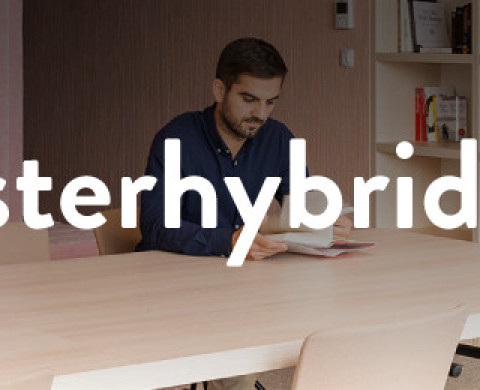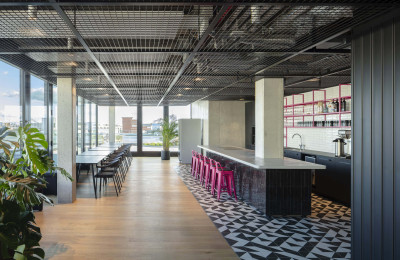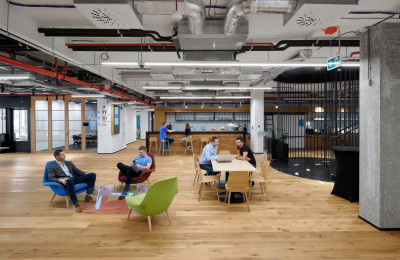Creating equality in the hybrid workplace
This week, our #masterhybridwork blog deep dives into the troubled waters of hybrid inequality. We’ve all heard about environments (and may have worked in some) where, for example, certain people get ahead more easily than others. Well, hybrid workplaces – where people spend time working both in the office and remotely – can lead to the same results.
It’s a big issue, because research by the Harvard Business School shows that 81% of workers would prefer to work hybrid post-pandemic. Here at HB Reavis, we’ve developed a wide range of hybrid-friendly services and technologies by Symbiosy and Origameo, some of which mitigate the issues surrounding inequality. But first, let’s explore what can go wrong.
Money can define who works remotely

Economic factors can have a huge impact on hybrid working, with some employees unable to afford the space or facilities to work remotely. Over time, there’s a clear chance that remote working will become synonymous with well-paid, white-collar occupations. And even then, they’ll be fewer remote workers within those occupations in less advanced economies.
Remote working can feel… remote
There’s a lot of truth in the phrase ‘out of sight, out of mind’. Even if we’re used to remote working technologies; research has proved that when someone is exposed to a familiar stimulus, they’ll rate it more positively than something they’ve not seen before.
This behaviour, called the ‘mere-exposure effect’, is completely unconscious. But when placed in a hybrid environment it can create an atmosphere of presenteeism, as employees slowly see managers prioritising people they regularly see in the office over those they usually interact with using digital tools. It’s something we touched on last week, when we discussed the importance of proximity to build strong interpersonal relationships.
Workloads can be too heavy – or too light
An important part of a manager’s job is making sure their team has the right quantity and quality of work.
In some ways, remote working technologies can actually make this easier. But a lack of investment in the right tools and training – not to mention employees’ unwillingness to use them – can lead to an uneven distribution of assignments and opportunities.
Firstly, managers might not be aware of people’s capabilities. They probably know what their colleagues achieved recently – but what about the historic experiences and skills that only get mentioned informally over lunch?
And secondly, managers might not properly set expectations. This doesn’t matter so much when you can simply walk to a desk and get more clarity. When you work remotely, it can be difficult to get the level of detail you need.

It’s tougher to assess performance
It’s likely we’ve all had issues with promotions and the perception of our performance. To give managers some due, it can be difficult to decide when and how to promote the right employee – balancing what they deserve against the impact on finances and a team.
The problem really comes from how performance is measured. As MIT wrote in an article: “companies rarely promote people into leadership roles who haven’t been consistently seen and measured. It’s a familiarity thing, and it’s a trust thing. We’re not saying that the people who get promoted are stars during every ‘crucible’ moment at the office, but at least they’re present and accounted for. And their presence says: Work is my top priority. I’m committed to this company. I want to lead. And I can.”
With hybrid working, remote settings can create a bias: we subjectively think that when employees aren’t around, they’re not contributing. Add the impact of managers taking charge of too many people, and technologies that fail to keep colleagues connected – and it’s easy to see how promotions can go to the wrong people, and have a knock on effect on both employee attrition and the bottom line.
Not all remote workspaces are equal
There’s no doubting that we work better when we’re comfortable. And remote working environments are not, by nature, as tailored for work as a good office.
The space itself may impact performance – from the quality of the air to surrounding biophilia, a lack of light to too much background noise, hot or cold temperatures to the availability of clean water, good food and quality beverages. And then there’s the equipment: how closely can a home office mimic a professional workspace’s performance design, inspirational accessories and workstation ergonomics?

It’s likely a senior leader will have all the things they need at home – with room to spare, and a nanny for the kids. But a junior team member might be working at a dining table, sat on a static chair rubbing elbows with a flatmate.
The solutions to fostering equality
There are a number of strategies to combating inequality in a hybrid environment. It’s a case of looking at where the issues are, formulating your own approach and getting everyone on board.
Clear and accessible rules
Most companies have well-defined HR structures and practices. But many still lack rules around hybrid working. These documents should be clear and accessible, and cover high-level topics like promotions, benefits and assignments as well as everyday activities – right down to how to dress for a video conference.
Focus on preventing distance bias
Bring in a ‘remote first’ rule. Positively discriminate remote participants at team meetings by asking for their views first and name checking them when inviting questions.
Make promotions transparent
Ensure promotions and bonuses are linked to clearly defined achievements. And that all team-members understand exactly what they need to achieve them.
Manage by objectives
Rather than focusing on presenteeism, assess performance on an employee’s ability to meet their objectives. Have KPIs in place for individuals and teams, and regular performance reviews to monitor progress.
Make the time for proper reviews
Relaxed, one-to-one conversations with individual team members are vital in a hybrid environment. It’s the time to discuss workloads, assess morale and talk shop.

Right now, just 8% of companies feel their performance management process drives business value, and 58% say it’s not an effective use of time. Yet research by PwC showed nearly 60% of respondents would like feedback on a daily or weekly basis – increasing to 72% among under 30s.
Make home feel like work
Keep abreast of your employees’ remote working conditions. If needed, provide support: it could be advice on how to structure their day or even equipment like chairs. And always allow people to work from the office if they can’t be productive at home.
If you’d like to learn more about the seven hybrid headaches, or want advice on maximizing your hybrid experience get in touch with Origameo.
Next week, we’ll be tackling headache number 5 – Professional Isolation. Sign up for alerts so you don’t miss it.
"*" indicates required fields




